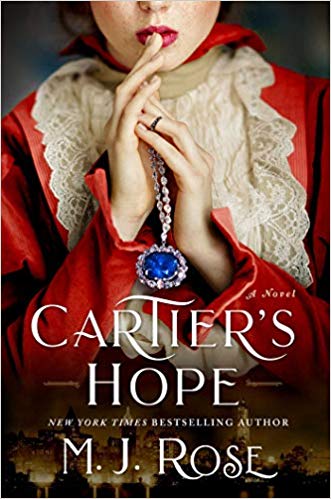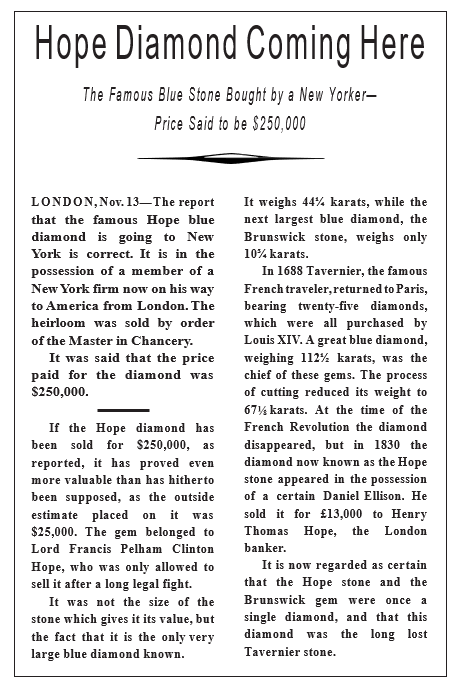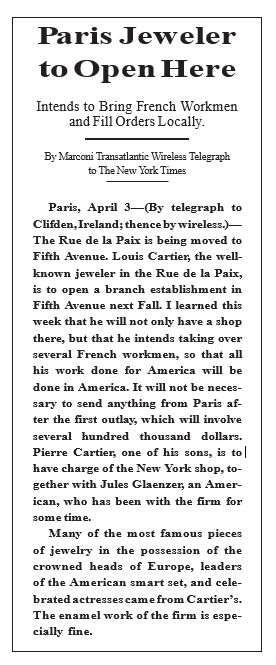

From the New York Times bestselling author of the “lush, romantic historical mystery” (Kristin Hannah, New York Times bestselling author of The Nightingale) Tiffany Blues, a gorgeously wrought novel following an intrepid female journalist in Gilded Age New York as she chases the story of the Hope Diamond.
New York, 1910: A city of magnificent skyscrapers and winding subways, where poor immigrants are crammed into tenements while millionaires thrive in Fifth Avenue mansions. Vera Garland is a thirty-two-year-old journalist, fighting alongside hundreds of women for a place in society, only to meet hurdles around every turn. Most female journalists are delegated to the fashion and lifestyle pages but like her hero, Nellie Bly, Vera is a fighter.
When news of the Hope Diamond—a jewel whose infamous legends and curses have captured the world’s attention—arrives in the city, Vera is fast on its trail. She’s certain the fabulous jewel will help jumpstart her career but she’s determined to seek revenge against her current employer, a magazine owner whose greed and blackmailing schemes led to the death of her beloved father.
Set against the backdrop of New York’s glitter and grit, this enchanting historical novel explores the very human desire for truth, equality, and retribution.
Cartier's Hope
From New York Times bestselling author M.J. Rose, comes a lush historical mystery set in Gilded Age New York. CARTIER’S HOPE is out today and I’m thrilled to share an excerpt from the novel below!



CHAPTER 1
New York City February 3, 1911
Diamonds, scientists say, are the world’s hardest material. And yet, like a heart, a diamond can break. When I was a reporter covering a story about the Hope Diamond, my research taught me that often a gem cut- ter will study a major stone for months, deciding where to strike, as cleaving is a precise and risky effort. If the jeweler misjudges, he can destroy the stone.
As a woman, I’ve learned the same thing. A single mistake can destroy a relationship.
Standing here in the cold, staring at the fountain in front of the Plaza Hotel, I try to pretend that I’m not really crying. That what look like tears are simply snowflakes melting on my cheeks.
But that’s just another lie. And I promised myself that I was done with lies. Untruths, whether by omission or commission, are how I got here—a place I never wanted to be and from which I am trying to escape.
For weeks and weeks, my sadness has felt oddly comforting. A proof of love. A reminder that even if I have lost that love, I did have it once. And now the time has come to fight for it. But am I willing to risk what is left of my pride? Willing to risk another failure even if there’s little—if any—chance of winning that love back?
My father once said, The fight is all. But so far, this fight has laid me bare, stripped me of all pretense, and broken my heart.
The snow is falling harder now, dressing the marble woman in the fountain in a gown of white. As more snow catches in my eyelashes and hair and lands on my face, melting and mixing with the tears, I wonder if my father was right.
This spot on Fifth Avenue between Fifty-eighth and Fifty-ninth Streets has been the epicenter of my city and so many moments in my life. To my right is Central Park, all dusted with white on this early evening—the living, breathing forest that has always been my refuge. To my left, across the avenue and down a block, is my father’s department store on Fifty-seventh Street, designed by my uncle and right in the heart of New York City’s newest fashionable uptown shopping district.
If I look downtown a bit farther and west, if I crane my neck just a little, I can see the rooftop gables of the building that houses Pierre Cartier’s jewelry shop.
But back to the fountain. In 1890, my father brought me to its installation ceremony. I was twelve years old. My sister was sick with a sore throat, so I was alone with him. My father spent a lot of time with me and always talked to me like an adult. He shared information about all the subjects he found interesting. The way fashions changed, how clothes and shoes and fabrics and jewelry were designed and made. How desire fueled commerce. What made someone want to buy something they didn’t need.
He was a great reader, especially of history. Ancient Rome, Egypt, Greece, the Renaissance, and seventeenth-century France were some of his favorite periods. And as we stood with the crowd that night with the fire- works bursting overhead, he told me the story of the woman whose form graced the fountain. Elpis, a symbol of hope.
“The first woman created by Zeus, Pandora,” he said, “had a jar—I believe it was a jar, not a box—that contained all the wonders of the world: life, renewal, love, generosity, wisdom, and empathy. Warned not to open the jar by Zeus, Pandora did her best to obey but ultimately gave in to temptation.” Here he stopped to give me a stern look to warn me about little girls who did not obey their fathers. “When she opened the jar, all the elements flew out. Beauty is limited, our health breaks down, our love fades. And we die. But it turned out that one thing remained in the jar after all—the one thing left to all of us when we face the tragedies in our lives. A tiny creature named Elpis, also known as hope. She stayed in Pandora’s jar so that she could revisit us after all our miseries. So that we can hope that the hard times will get better, hope that grief will soften, hope that terrors will quell.”
As I remember this moment, my heart aches. How much love can you lose and still have hope that you will ever find love again? And if you do find it, how can you know that it will last for any time at all?
My father had tried to teach me that love, no matter how short-lived, was worth fighting for. Worth savoring. He always spoke of it with a wistfulness I never quite understood. For years, I wondered where his sadness came from. A successful businessman, father, and husband, he didn’t seem to have had any tragedy in his life.
But that was a feeling. Not a fact. I am a reporter; I know how important the facts are. And when I discovered the facts of my father’s past, they changed my life.
One of those facts was that my father had, indeed, endured a terrible tragedy a few weeks before he died. Another fact was that he had tried to hide it from me, as well as from my sister and my mother. Yet another fact was that in Paris in 1909, C. H. Rosenau sold a forty-five-carat blue diamond to Pierre Cartier, grandson of the French jeweler who had founded the world-renowned maison. It is another fact that in January 1911, Evalyn Walsh McLean and her husband purchased that same stone from Cartier.
Between those facts is a tale rich with revenge, robberies, myths, curses, psychics, lost fortunes, outright lies, murder, and heartache. And just a few months ago, it became my job as an investigative journalist to look at all the different facets of the story of the diamond originally known as the French Blue—but now known as the Hope—for a weekly magazine called the Gotham Gazette.
During the course of my probing, questioning, and reporting, I learned many things about history, power, jewelers, society, wealth, passion, greed, and love.
I started out the investigation, ironically, feeling quite hopeless myself, having lived a life that was dark and dreary. It’s been a long and circuitous route to come to the end of the investigation. But therein lies my tale. A story that will come to its conclusion one way or another tonight and will very possibly change the direction the rest of my life will take.
My father told me to hold on to love even when the world around me tried to snatch it away. And I have. I’ve held tightly to its promise all these long months. I’ve imagined it wrapped up in some of the navy velvet my father’s emporium sells on the second floor. Tied with a magenta ribbon from the notions department.
And tonight I will find out if I can unwrap it or if I will need to walk into the park across the street and find a soft patch of ground in which to bury it once and for all.
Like my father, I wouldn’t give up what I’ve had for anything. But oh, how I hope that I’ll find it again. When you fall in love, you aren’t smart. You don’t weigh the logic of your actions. You don’t look at the man to whom you are giving your heart with the cold precision of a diamond cutter examining that rough stone. At least, I didn’t. And so the man I’d given my heart to turned out to be a thief.















 by
by